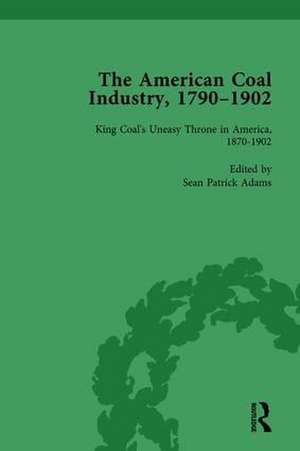The American Coal Industry 1790–1902, Volume III: King Coal's Uneasy Throne in America, 1870-1902
Autor Sean Patrick Adamsen Limba Engleză Hardback – dec 2013
The third volume in this set traces the three decades following the American Civil War, during which time the use of coal for manufacturing, locomotives and domestic heating helped build a dynamic industrial economy in the United States. Mineral fuel growth powered the growth of the nation and by 1885 coal became the single most important source of American energy. Coal mining spread to nearly every corner of the nation in the half-century following the civil war. By the time of the Great Anthracite Strike in 1902, the American coal industry was a truly national phenomenon. The rise of large and well-funded mining and railroad corporations, the national unions, and the inroads by state governments into mine safety all suggest a significant reshaping had occurred.
Preț: 652.84 lei
Preț vechi: 985.02 lei
-34% Nou
Puncte Express: 979
Preț estimativ în valută:
124.93€ • 131.03$ • 103.99£
124.93€ • 131.03$ • 103.99£
Carte tipărită la comandă
Livrare economică 01-15 aprilie
Preluare comenzi: 021 569.72.76
Specificații
ISBN-13: 9781138757660
ISBN-10: 1138757667
Pagini: 398
Dimensiuni: 156 x 234 mm
Greutate: 0.45 kg
Ediția:1
Editura: Taylor & Francis
Colecția Routledge
Locul publicării:Oxford, United Kingdom
ISBN-10: 1138757667
Pagini: 398
Dimensiuni: 156 x 234 mm
Greutate: 0.45 kg
Ediția:1
Editura: Taylor & Francis
Colecția Routledge
Locul publicării:Oxford, United Kingdom
Public țintă
Academic and PostgraduateCuprins
Volume 3 King Coal’s Uneasy Throne in America, 1870–1902 Introduction Charles Reemelin, Benjamin M. Skinner and Andrew Roy, Report of the Mining Commission Appointed under Joint Resolution of the General Assembly of the State of Ohio, Passed May 2d, 1871, to his Excellency the Governor Rutherford B. Hayes. November 14th, 1871 (1872), extract Israel W. Morris, The Duty on Coal, Being a Few Facts Connected with the Coal Question, Which Will Furnish Matter for T ought to the Friends of American Industry (1872) Philadelphia Coal Exchange, The Coal Monopoly. The Coal Trade of Philad’a in Reply to the President of the Philadelphia & Reading Railroad Company. With the Charter of the Laurel Run Improvement Company, Now the Philadelphia and Reading Coal and Iron Company (1873) James McKillop, ‘A Visit to the Coal Mines of America’, in Coal and American Coal Mining (1876), extract F. A. Herwig, The Present Management of the Reading Railroad, as It Affects the Coal Regions, the Coal Miners and Consumers (1879) The Coal Dealer Conspiracy: Selected Articles from the Chicago Tribune, 1880–6 Anon., ‘A Serious Question’, Chicago Tribune, 25 November 1880 Anon., [‘The Coal Dealers’], Chicago Tribune, 10 May 1881 ‘M. C.’, ‘The Coal Dealers’ Conspiracy’, Chicago Tribune, 15 December 1881 Anon., ‘The West and the Coal Combination’, Chicago Tribune, 28 July 1883 Anon., ‘The Coal Question. A Retail Dealer’s Views on the Question’, Chicago Tribune, 17 May 1885 1Anon., ‘The Coal Combination’, Chicago Tribune, 5 October 1886 1John McBride, ‘Coal Miners’, in George E. McNeill (ed.), The Labor Movement: The Problem of To-day (1887) Charles Miesse, Points on Coal and the Coal Business … History of the Anthracite Coal Field and its Surroundings (1887), extract Chris Evans, History of the United Mine Workers of America, Volume II: From the Year 1890 to 1900 (1918), extract Anthracite Coal Strike Commission, Report to the President on the Anthracite Coal Strike of May–October, 1902 (1903), extract Editorial Notes List of Sources Index
Descriere
During the nineteenth century the American economy was able to expand rapidly due to the availability of cheap and plentiful supplies of coal. This primary resource collection covers all aspects of this important energy source through a selection of letters, pamphlets, industry reports and newspaper articles. The third volume in this set traces the three decades following the American Civil War. By the time of the Great Anthracite Strike in 1902, the coal industry was a national phenomenon. The rise of large, well-funded mining and railroad corporations, the national unions, and the inroads by state governments into mine safety all demonstrate that a significant reshaping had occurred.
